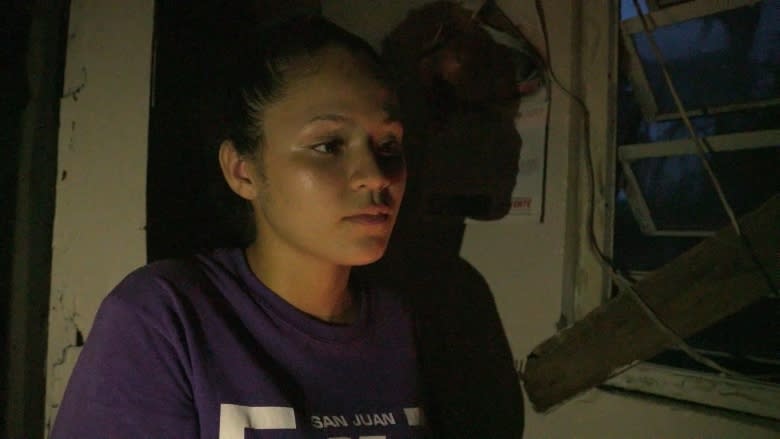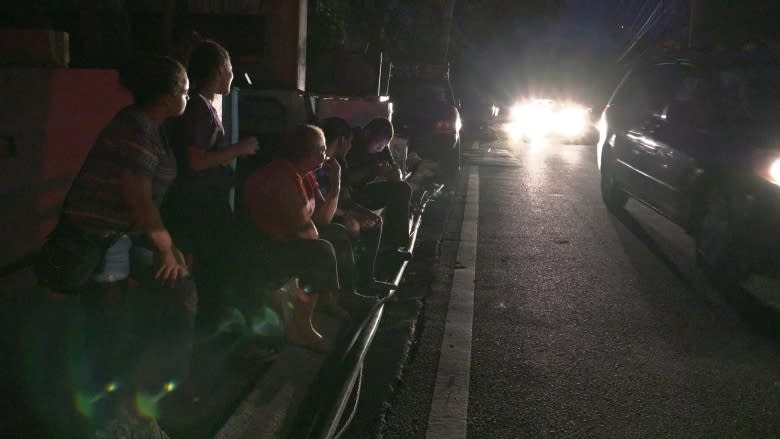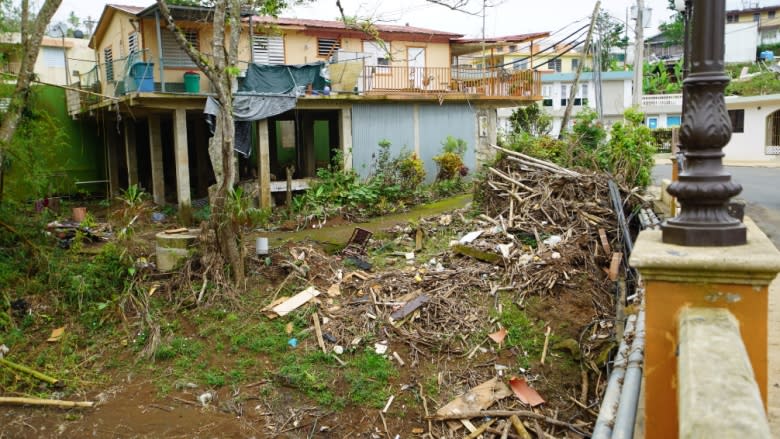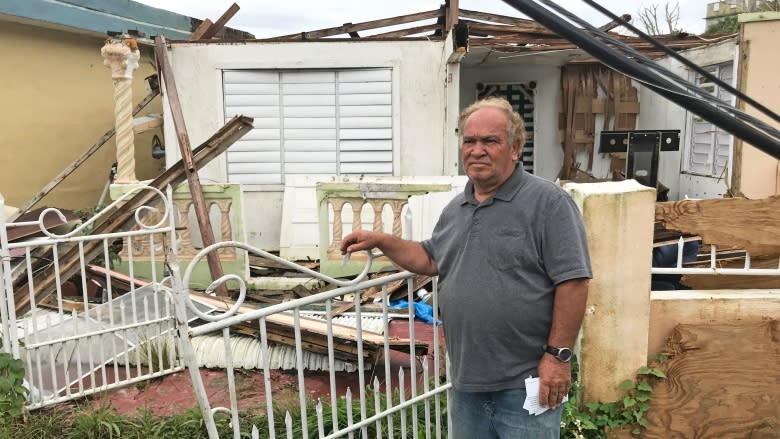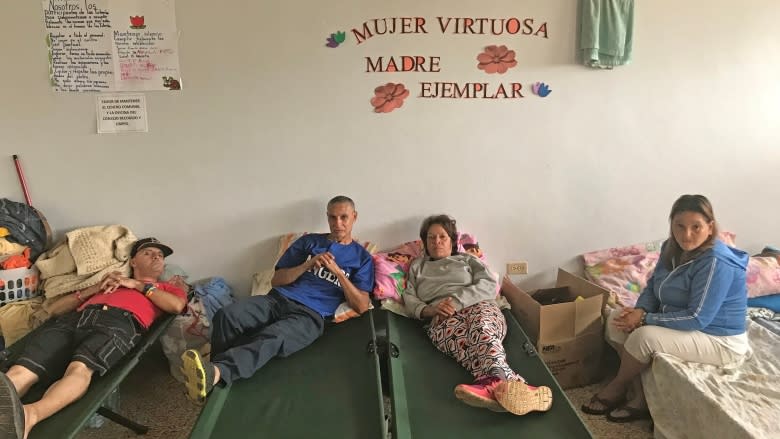Puerto Rico's misery: Thousands without homes, power 2 months after storms
In the capital of San Juan, the sound slices through the smothering nighttime darkness, even through the constant drone of generators. It's the croaking of the coqui, a tiny frog native to Puerto Rico. The symphony begins at nightfall, emerging as a companion to all the weariness.
The headlights of passing cars are all that illuminate a family sitting on the cement shoulder on the side of a busy road. Naiyia Ris and her family lost power on Sept. 6, when Hurricane Irma hit.
Three weeks later, Hurricane Maria tore through the island and took their hope with it.
"It's very hard — no electricity, mosquitoes, the heat — it's very hard," Ris says. "I feel frustrated. We need help. I know places [were] more affected by Hurricane Maria, but we're also people of Puerto Rico and we need help."
Puerto Rico is a territory of the United States and its residents are U.S. citizens. Still, help from the American government has been slow and spotty, particularly for people in outlying areas.
Many have been reduced to living in primitive conditions because of storm damage to the island's basic infrastructure.
Two months after Hurricane Maria, power is slowly being restored to some parts of the impoverished American territory, but most of the island's 3.5 million people are still living in the dark.
Ris and the seven other members of her family who share a tiny home are among those without electricity. She leads us through the dark with a small flashlight. It's stifling inside, the stench of sewage trapped in the humid air.
Bags of ice keep their food cool. Like most people in Puerto Rico, the Ris family can't afford a generator or the fuel to run it.
"It's hard because we need to see, we need to communicate," Ris says. "I need to stay positive. I don't know how to. I need to believe there will be light."
'It's a very hard situation'
Outside of San Juan, dozens of towns have no electricity or running water.
Power isn't the only problem. Heading to the central mountain town of Barranquitas, what's usually a one-hour drive takes three because of washed out roads and collapsed bridges.
Jacqueline Sierra's home stands next to a gaping crevice where a bridge once was. Aid has barely trickled into this region and it hasn't reached her yet.
"How do I feel? Very bad! It's a very hard situation," she says. "We adapt and find ways to live, but it's not easy. It's not easy.
"When the night comes, it's even harder. It's very dark. You can't see anything," she says, adding that she's fearful of looters. "We need to shut the door early, like 5 or 6 p.m. we shut the door because it's dangerous."
'No one has come'
The scale of devastation is staggering. The landscape is dominated by broken trees and felled power lines.
Nearly 500,000 homes were destroyed when the Category 5 hurricane made landfall on Sept. 20. Mattresses, furniture, childrens' toys, sodden and broken possessions of every kind are still strewn on the side of roads.
Edwin Colon stands in front of the ruins of his home near the town of Albonito and invites us in. He shares his story with the eagerness of someone who feels forgotten. The hurricane's ferocious winds ripped the roof off his home, mangling everything inside. Colon says he's on medication, to curb the gnawing bouts of anxiety that now overwhelm him.
"This bedroom furniture was new," he says as he carefully walks over piles of debris.
"I had bought this a month before the hurricane. It's hard. I feel sad. Very sad," he says. He has no idea when power crews or help with housing will arrive. "No one has come."
Sluggish relief effort
Fixing generating stations is one thing, but transmission is another steep challenge. The island's electrical grid, crippled after years of neglect, is now decimated. The government of Puerto Rico has asked U.S congress for a $94.4 billion US relief package.
Puerto Rico Gov. Ricardo Rossello has pledged to restore power to 95 per cent of the island's residents by mid-December. Meanwhile, the U.S. Army Corps of Engineers is less optimistic, saying it expects to reach just 75 per cent by the end of January.
Congress has already approved nearly $5 billion in aid. The Federal Emergency Management Agency (FEMA) is leading a sluggish recovery effort, complicated by the washed out roads and spotty communication.
It took a month for FEMA to open an aid centre just outside Barranquitas. Hundreds now stream in every day. The main request is help with housing.
Elsa Avides came to register for a blue tarp that will serve as a temporary roof. She says life now is all about bracing for the next rainfall.
"I get a huge stress every time it rains, thinking my house will get all wet inside," she says. "I have to put down towels and comforters to absorb it, and in the closets so my clothes don't get wet from the rain that falls inside the house."
FEMA plans to airlift people who have no homes left to repair. They'll eventually join more than 130,000 Puerto Ricans who have already fled to the U.S. mainland looking for jobs and shelter.
Meanwhile, thousands are stuck here in shelters across the island, their lives suspended.
Annabelle Colon is one of them. In the hour we spend at the shelter she sits barely moving on her cot, staring blankly ahead at an empty future.
"My house is uninhabitable because of the roof and the floor, because the floor has unlevelled," she says. "The hardest part of waiting is that I could end up with nothing."

